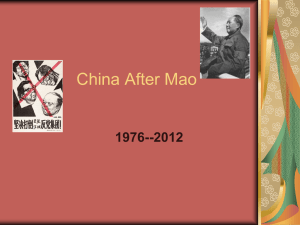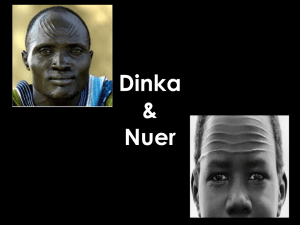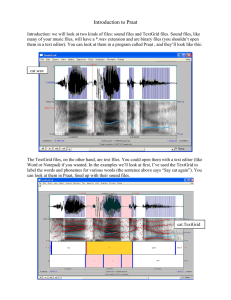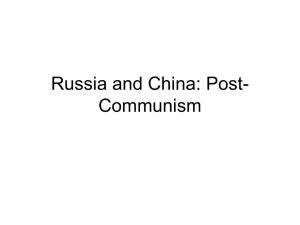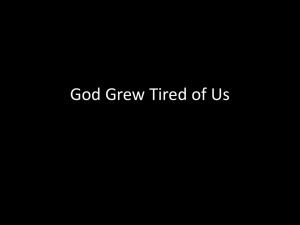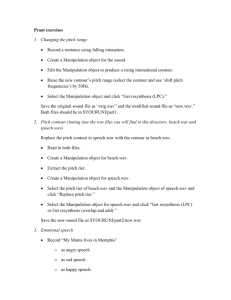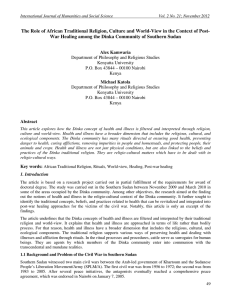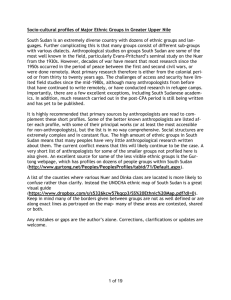readme - Edinburgh DataShare
advertisement
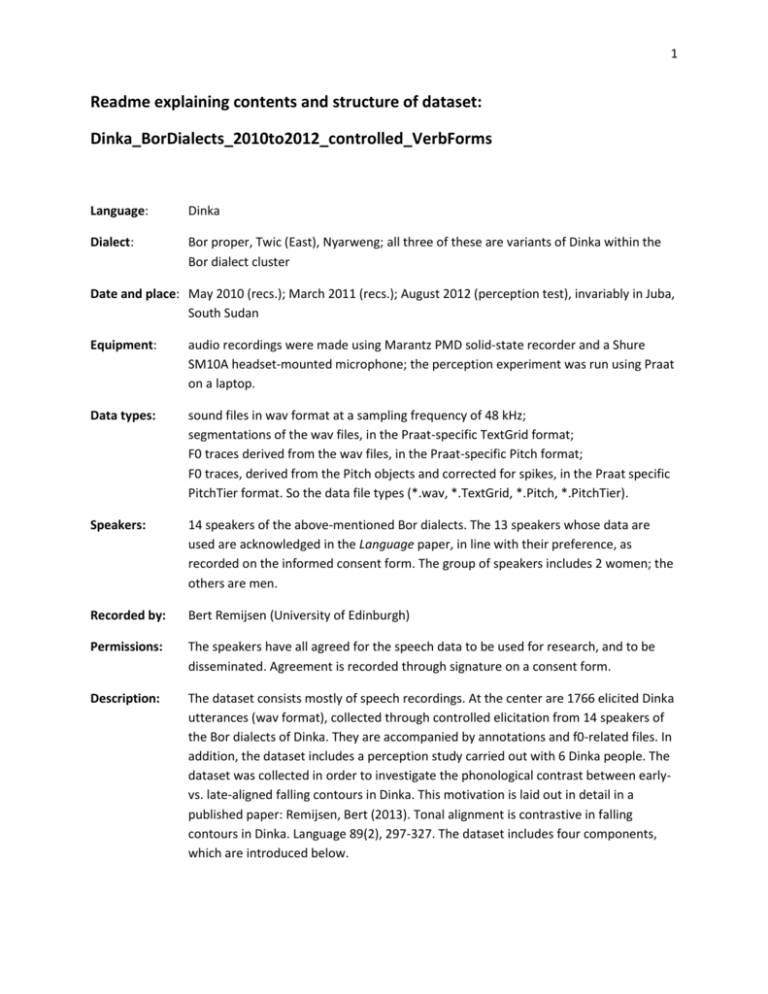
1 Readme explaining contents and structure of dataset: Dinka_BorDialects_2010to2012_controlled_VerbForms Language: Dinka Dialect: Bor proper, Twic (East), Nyarweng; all three of these are variants of Dinka within the Bor dialect cluster Date and place: May 2010 (recs.); March 2011 (recs.); August 2012 (perception test), invariably in Juba, South Sudan Equipment: audio recordings were made using Marantz PMD solid-state recorder and a Shure SM10A headset-mounted microphone; the perception experiment was run using Praat on a laptop. Data types: sound files in wav format at a sampling frequency of 48 kHz; segmentations of the wav files, in the Praat-specific TextGrid format; F0 traces derived from the wav files, in the Praat-specific Pitch format; F0 traces, derived from the Pitch objects and corrected for spikes, in the Praat specific PitchTier format. So the data file types (*.wav, *.TextGrid, *.Pitch, *.PitchTier). Speakers: 14 speakers of the above-mentioned Bor dialects. The 13 speakers whose data are used are acknowledged in the Language paper, in line with their preference, as recorded on the informed consent form. The group of speakers includes 2 women; the others are men. Recorded by: Bert Remijsen (University of Edinburgh) Permissions: The speakers have all agreed for the speech data to be used for research, and to be disseminated. Agreement is recorded through signature on a consent form. Description: The dataset consists mostly of speech recordings. At the center are 1766 elicited Dinka utterances (wav format), collected through controlled elicitation from 14 speakers of the Bor dialects of Dinka. They are accompanied by annotations and f0-related files. In addition, the dataset includes a perception study carried out with 6 Dinka people. The dataset was collected in order to investigate the phonological contrast between earlyvs. late-aligned falling contours in Dinka. This motivation is laid out in detail in a published paper: Remijsen, Bert (2013). Tonal alignment is contrastive in falling contours in Dinka. Language 89(2), 297-327. The dataset includes four components, which are introduced below. 2 Main Set (data in Dinka_BorDialects_2010to2012_controlled_VerbForms_MainSet) The data in this compressed folder form the basis of the production study described in section 3 of the Language paper. The folder contains 1571 wav files. For most of these, there are corresponding TextGrid, Pitch, and PitchTier objects. But the folder also contains utterances that were not part of the analysis, because of hesitation, unintended grammatical forms. Data from one speaker was excluded altogether, because it was unclear which dialect he belongs to.1 His data all begin with BB_06. To extract all and only those files used in the acoustic analysis in section 3 of the Language paper, the files should be selected on the basis of the TextGrid extension. That is, all files for which there is a TextGrid were included in the analysis. Structure of the file name of data files (*.wav, *.TextGrid, *.Pitch, *.PitchTier): The file name of each data file encodes several pieces of information, through fields that are separated by an underscore (_). Fields 1,2,3 invariably contain the same type of information, as does the final field. The information in fields 4 to n-1 depends primarily on the value of field 3. The use of this filenames can be easily understood on the basis of the glossed examples in the Language paper. Field 1: dialect code. In this case, BB, TB, NB. The first character codes for the dialect variety level: Bor (proper), Twic (East) and Nyarweng, respectively. The second character codes for the cluster level, which is Bor for all three of these varieties. Field 2: speaker number. Speakers are numbered consecutively. The numbering is not limited to this study. Field 3: utterance type. The information in fields 4 to n-1 depends primarily on the value of this field. EXIST stands for existential predicate. If field 3 is EXIST, then fields 4 and 5 specify the English translation of the noun and its inflection, respectively. In field 5 S or SG stands for singular and P or PL for plural. ISOL stands for the citation or isolation form. If field 3 is ISOL, then fields 4 and 5 specify the English translation of the noun and its inflection, respectively. In field 5 S or SG stands for singular and P or PL for plural. VA stands for verb+argument. Most of the data in this dataset have this value in the third field. If field 3 is VA, then fields 4 and 5 specify the English translation of the verb and its inflection, respectively, and fields 6 and 7 specify the English translation of the internal-argument noun and its inflection, respectively. Following a verb in field 4, field 5 can be PAST, the past-tense infinitive construction; ZERO, the unmarked presenttense form; NTS&1SG: the object is in preverbal position, and the 1st singular agent is encoded stem-internally on the stem syllable of the verb; NTS&2SG and NTS&3SG are comparable but with 2nd and 3rd singular agents, respectively; PASS: passive; NTS: marked order, in which the unmarked order of SVO/SOV is reversed, so that the object appears at the beginning of the clause (cf. work on Dinka by Torben Andersen). Field n: the last field in the file name is the repetition number. 1 This was assessed based on unrelated data, in particular his realisation of the voice quality contrast. 3 Extra (data in Dinka_BorDialects_2010to2012_controlled_VerbForms_Extra) The data in this compressed folder form the basis of qualitative analysis (including time-normalised F0 plots) in section 2 of the Language paper. The folder contains 65 wav files. For most of these, there are corresponding TextGrid, Pitch, and PitchTier objects. The data come from 4 speakers of Bor proper,a nd one speaker of Twic (East). Section 2 in the paper focuses on the evidence from the four speakers of Bor (proper – referred to as Bor South in the paper). Structure of the file name of data files (*.wav, *.TextGrid, *.Pitch, *.PitchTier): The structure of the file names is as for Main Set (see above). There are a few additions, explained below. The use of this filenames can be easily understood on the basis of the glossed examples in the Language paper. Fields n-2, n-1 If field n-2 contains ADV, then the sentence ends with an adverb. The translation of the adverb follows in field n-1. Field 7 If field ends with &MODIF, then fields 8 and 9 specify this modifier and its own inflection, respectively. Trigger (data in Dinka_BorDialects_2010to2012_controlled_VerbForms_Trigger) The data in this compressed folder were included in the first submission of the paper in Language paper, but taken out when it became clear that the paper was too dense. So I took it out, trying to say less and get more of it across. The goal of the Trigger data was to compare the realisation of a Low tone following a non-High target on the preceding syllable with its realisation when there is a High target on the preceding syllable. The basis past tense in the Bor (proper) has a past-tense auxiliary /ēe/. The same dialect also has a segmentally identical auxiliary /ée/, which express an aspectual meaning like habitual. The future tense involves the auxiliary /bí̤/. I elicited a number of Low-toned nouns, each following these auxiliaries. The folder contains 130 wav files. For most of these, there are corresponding TextGrid and Pitch objects. The nouns are /nòoon/ ‘grass:SG’, /mòoc/ ‘man:SG’, /mìiir/ ‘giraffe’, /bá̤ ɲ/ ‘chief:SG’. The subject is mostly the proper noun /dèeŋ/ ‘Deng’. The verbs are – in past-tense infinitive form – /ŋēeer/ ‘cut2:PAST’ (the number distinguishes it from e.g. /tēeem/, which also relates to cutting)’, /máaan/ ‘hate:PAST’, /léeel/ ‘provoke:PAST’, /nēeem/ ‘visit:PAST’. The materials are listed in the Table below. Structure of the file name of data files (*.wav, *.TextGrid, *.Pitch, *.PitchTier): The structure of the file names is as for Main Set (see above). In field 5, I additionally used codes to mark that the verb construction is FUT (future) or HABIT (habitual). Table: The materials in the Trigger dataset. Block 1 Present Dèeŋ ā-nèem mòoc ‘Deng is visiting a man.’ 4 Block 2 Block 3 Block 4 Past Dèeŋ ēe mòoc nēeem ‘Deng has visited a man.’ Future (different object) Dèeŋ ā-bí̤ bá̤ ɲ nēeem ‘Deng will visit a chief.’ Habitual Dèeŋ ée mòoc nēeem ‘Deng is always visiting a man.’ Present Dèeŋ a-ŋèer nòoon ‘Deng is cutting grass.’ Past Dèeŋ ēe nòoon ŋēeer ‘Deng has cut grass.’ Future (different object) Dèeŋ a-bí̤ wǎ̤ al ŋēeer ‘Deng will cutt grass.’ Habitual Dèeŋ ée nòoon ŋēeer ‘Deng is always cutting grass.’ Present Dèeŋ a-màan mòoc ‘Deng is hating a man.’ Past Dèeŋ ēe mòoc máaan ‘Deng has hated a man.’ Future (different object) Dèeŋ a-bí̤ bá̤ ɲ máaan ‘Deng will hate a chief.’ Habitual Dèeŋ ée mòoc máaan ‘Deng is always hating a man.’ Present Dèeŋ ā-lèel mìiir ‘Deng is provoking a giraffe.’ Past Dèeŋ ēe mìiir léeel ‘Deng has provoked a giraffe.’ Future (different object) Dèeŋ ā-bí̤ aɲáaar léeel ‘Deng will provoke a buffalo.’ Habitual Dèeŋ ée mìiir léeel ‘Deng is always provoking a giraffe.’ Perception study (data in Dinka_BorDialects_2010to2012_controlled_VerbForms_PerceptionStudy) This folder contains the stimuli and responses of the perception test, plus the Praat code (MFC) which I used to run the perception test in South Sudan. Further details on the procedure can be found in the Language paper.

